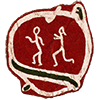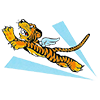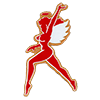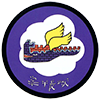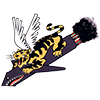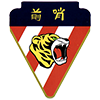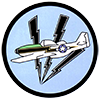The American Volunteer Groups
The American Volunteer Groups were volunteer air units organized by the United States government to aid the Nationalist government of China against Japan in the Second Sino-Japanese War. The only unit to actually see combat was the 1st AVG, popularly known as the Flying Tigers.
In an effort to aid the Nationalist government of China and to put pressure on Japan, President Franklin Roosevelt in April 1941 authorized the creation of a clandestine "Special Air Unit" consisting of three combat groups equipped with American aircraft and staffed by aviators and technicians to be recruited from the U.S. Army, Navy and Marine Corps for service in China. The program was fleshed out in the winter of 1940–1941 by Claire Lee Chennault, then an air advisor to the Chinese Nationalist leader Chiang Kai-shek, and Lauchlin Currie, a young economist in the Roosevelt White House. They envisioned a small air corps of 500 combat aircraft, although in the end, the number was reduced to 200 fighters and 66 light bombers.[1]
1st Pursuit Squadron AVG (Flying Tigers)
Flying Tigers
The 1st American Volunteer Group were recruited starting on 15 April 1941, when an unpublished executive order was signed by President Roosevelt.[2]A total of 100 P-40Bs were obtained from Curtiss-Wright by convincing the British Government to take a later batch of more advanced P-40s in exchange.[2] The group assembled at a Royal Air Force airfield in Burma by November 1941 for training, where it was organized into three squadrons and established a headquarters.[3] The Flying Tigers did not go into combat until after the Japanese attack on Pearl Harbor on 7 December 1941.[2] Under Chennault's command, the Flying Tigers became famous in the defense of Burma and China.[2] It was replaced by the U.S. Army 23rd Fighter Group in July 1942.[4]
2nd Pursuit Squadron AVG (Flying Tigers)
In the fall of 1941, the 2nd American Volunteer Group was equipped with 33 Lockheed Hudson (A-28) and 33 Douglas DB-7 (A-20) bombers originally built for Britain but acquired by the U.S. Army as part of the Lend-Lease program passed earlier in the year. The Central Aircraft Manufacturing Company, fronting for the Chinese and American governments, recruited 82 pilots and 359 ground crewmen from the U.S. Army in the fall of 1941, and an undetermined number, including one pilot, actually sailed for Asia aboard Noordam and Bloemfontein of the Java-Pacific line. Other pilots reported to San Francisco, and were scheduled to depart aboard the Lockheed Hudsons on 10 December. The Douglas DB-7s, meanwhile, were to have gone by freighter to Africa, where they would be assembled and ferried to China. However, the attack on Pearl Harbor caused the program to be aborted. The vessels at sea were diverted to Australia, the aircraft were taken back into American service, and most or all of the personnel likewise rejoined the military, either in Australia or in the U.S.
3rd Pursuit Squadron AVG (Flying Tigers)
The 3rd AVG was to have been a fighter group like the 1st. Because the 2nd AVG had been recruited from the U.S. Army, recruiting for the 3rd was to have been limited to the U.S. Navy and Marine Corps, starting in the early months of 1942. These plans too were abandoned as a result of the U.S. entry into World War II.
23th FG - 16th FS - 74th FS - 74th FS var - 75th FS - 76th FS - 118th TRS
23rd Fighter Group
Constituted as 23rd Pursuit Group (Interceptor) on 17 Dec 1941. Redesignated 23rd Fighter Group in May 1942. Activated in China on 4 Jul 1942. Chennault's American Volunteer Group supplied experienced pilots and a name - "Flying Tigers." Using P-40's and later P-51's, the 23rd group provided air defense for the Chinese terminus of the Hump route from India; conducted a counter-air campaign to whittle down Japanese air strength by destroying enemy planes in the air and on the ground; strafed and bombed Japanese forces, installations, and transportation; escorted bombers; and flew reconnaissance missions. It intercepted Japanese planes that attempted to bomb Allied airfields; attacked Japanese airdromes; strafed and bombed river craft, troop concentrations, supply depots, and railroads; and protected bombers that attacked Hong Kong, Canton, Shanghai, and other targets. Its area of operations extended beyond China to Burma, French Indochina, and Formosa. The "Flying Tigers" operated against the Japanese during the enemy's drive toward Changsha and Chungking in May 1943, supported Chinese forces during the Japanese offensive in the Tungting Hu region in Nov 1943, and took part in the effort to halt a Japanese force that pushed down the Hsiang Valley in Jun 1944. In the latter battle the group, despite bad weather and heavy flak, repeatedly struck boats, trucks, aircraft, troops, and other objectives, receiving a DUC for its operations. The 23rd helped to turn the enemy's offensive in the spring of 1945 and then harassed the retreating Japanese by strafing and bombing their columns. Remained in China until Dec 1945. Moved to the US. Inactivated on 5 Jan 1946.
Activated on 10 Oct 1946 on Guam. Assigned to Far East Air Forces and equipped with P-47 aircraft. Moved to the Panama Canal Zone in Apr 1949. Inactivated on 24 Sep 1949.
Redesignated 13th Fighter-Interceptor Group. Activated in the US on 12 Jan 1951. Assigned to Air Defense Command and equipped with F-86's. Inactivated on 6 Feb 1952.
Redesignated 23rd Fighter Group (Air Defense). Activated on 18 Aug 1955. Assigned to Air Defense Command. Equipped with F-89 aircraft.
Squadrons. 16th: 1942-1943. 74th: 1942-1946; 1946-1949; 1951-1952. 75th: 1942-1946; 1946-1949; 1951-1952; 1955-. 76th: 1942-1946; 1946-1949; 1955-. 132d: 1951. 134th: 1951.
Stations. Kunming, China, 4 Jul 1942; Kweilin, China, c. Sep 1943; Liuchow, China, 8 Sep 1944; Luliang, China, 14 Sep 1944; Liuchow, China, Aug 1945; Hangchow, China, c. 10 Oct-12 Dec 1945; Ft Lewis, Wash 3-5 Jan 1946. Guam, 10 Oct 1946; Howard AFB, CZ, 25 Apr-24 Sep 1949. Presque Isle AFB, Maine, 12 Jan 1951-6 Feb 1952. Presque Isle AFB, Maine, 18 Aug 1955-.
Commanders. Col Robert L Scott Jr, 4 Jul 1942; Lt Col Bruce K Holloway, Jan 1943; Lt Col Norval C Bonawitz, 16 Sep 1943; Col David L Hill, 4 Nov 1943; Lt Col Philip C Loofbourrow, 15 Oct 1944; Col Edward F Rector, 12 Dec 1944-c. Dec 1945. Col Lester S Harris, 10 Oct 1946; Maj Leonard S Dysinger, 1 Nov 1947; Lt Col Hadley V Saehlenou, Nov 1947-unkn; Col Louis R Hughes Jr, 1 Sep 1948-unkn. Unkn, Jan-Jul 1951; Col Norval K Heath, c. Jul 1951-6 Feb 1952. Col Frank Q O'Connor, 1955; Lt Col Frank Keller, Dec 1955-.
Campaigns. India-Burma; China Defensive; Western Pacific; China Offensive.
Decorations. Distinguished Unit Citation: Hunan Province, China, 17-25 Jun 1944.
Insigne Shield: Azure, over a bolt of lightning, in pale, or, a Flying Tiger proper, tongue red, winged argent; all outlines black; a diminutive border silver-grey. (Approved 24 Jan 1957.)
Mingladon Rangoon Burma Map
Cumming, China Map
Guilin, Guangxi, China Map Map
Kunming, Yunnan, China Map
References
3. Rossi, J.R. 'A Flying Tiger's Story by Dick Rossi.' Planes and Pilots Of World War Two, 1995.
Bibliography:
Armstrong, Alan. Preemptive Strike: The Secret Plan That Would Have Prevented the Attack on Pearl Harbor. Guilford, Delaware: Lyons Press, 2006. ISBN 1-59228-913-4.
Ford, Daniel. Flying Tigers: Claire Chennault and His American Volunteers, 1941–1942. Washington, DC: HarperCollins|Smithsonian Books, 2007. ISBN 0-06-124655-7.
Leonard, Royal. I Flew for China: Chiang Kai-Shek's Personal Pilot New York: Doubleday, Doran, 1942.
Schaller, Michael. The U.S. Crusade in China, 1938–1945. New York: Columbia University Press, 1979. ISBN 0-231-04455-0.
 Editor for Asisbiz: Matthew Laird Acred
Editor for Asisbiz: Matthew Laird Acred
If you love our website please add a like on facebook
Please donate so we can make this site even better !!



